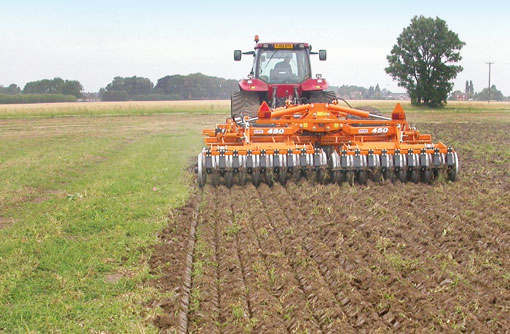Tillage-Live: Soil structure key to cultivation plans

Soil conditions need to be assessed on a field-by-field basis, not only to suit the following crop but also the weather and season, according to independent soil and machinery specialist, Philip Wright.
To start with, identify problem areas, usually where there’s evidence of the effects of compaction such as lower yields and wet areas in the growing season.
Reducing the cause of compaction is an obvious first step, he adds. “The first pass of traffic can cause 75% of the damage, made worse by high tyre pressure and axle loads with high wheelslip in wet conditions, damage can go down as far as 50cm with 20t axle loads,” he adds.
Tyre pressures are also crucial, particularly when the soil isn’t in good condition. “As soils become wetter they can become ‘plastic’ and unworkable,” explains Mr Wright. “It’s become ‘plastic’ when you roll the soil in your hands and it comes out like a long worm. In this case it needs to dry out, as cultivating in these conditions is generally counter-productive.”
And track users aren’t immune from compaction problems either, he adds. “Ballasting to achieve the correct balance is critical where the flexible rubber tracks run around idlers to prevent peak loads causing compaction.”
Spade work
Plant remains can indicate signs of compaction and lots of fibrous strands coupled with long tap roots indicate a good soil structure, he explains. “Dig a small pit about two spade lengths (40cm-60cm) wide and extend this across wheelings or other areas where you think there are problems.”
Dig the spade in beyond one side to get a slither and slice it away from the side of the pit, looking carefully at how the layers separate naturally. If these fall in layers that peel away, it shows there has been a change in structure, Mr Wright says. “Massive clods, a plate-like formation or roots that have grown along horizontal cracks indicate poor structure.”
If there are these problems at the bottom of the hole, deeper work is needed, he warns. “While horizontal cracks are bad news, vertical cracks are good.” Oilseed rape is an excellent indicator of structural issues, as the deep tap roots swerve away horizontally if there’s a compaction problem.
When’s best to cultivate?
The dry spring this year will have left a hard lower layer in many places, and trying to penetrate this layer when there’s a damp or slippery surface can cause even more trouble. “If this is the case it may be better to wait for more rain to penetrate at a deeper level.”
The ideal time to cultivate is when the soil is at, or slightly drier than, its lower plastic limit, when it starts to crumble easily.
Top tips for planning a cultivation strategy
• Use the previous crop’s roots and yields to guide you to areas of compaction and structure problems
• Always check soil structure before cultivating
• If there is nothing wrong – don’t fix it. Don’t waste time, fuel and money on curing problems that don’t exist
• Prevent problems by lowering tyre pressures or by investing in the latest types of tyre technology, such as radials
• Confine heavily loaded trailers to tramlines and known tracks to localise compaction to treatable areas. Minimise wheelings wherever possible
• Consider partially loading trailers in extremely wet conditions
• Think about each field on its own merits
• Treat headlands separately and drill headlands last
• Consider loosening headlands again ahead of drilling if conditions require and/or allow
• Set and adjust the machine for prevailing conditions
• Check after the machine to ensure it is actually achieving what is required and not making things worse
• Ensure tines are not working below their critical depth – maintain wearing parts in effective condition
• Avoid excessive soil movement at depth and ensure it is moving upwards not sideways
• Check the cracking: many vertical cracks – good; horizontal cracks – bad
• Aim to retain the soil structure’s strength – do not weaken it with overworking
• Patience is a virtue: Try, whenever possible, to wait for conditions – wet or dry – to improve
• Maintain field drainage systems properly and exploit opportunities to reinstate mole drains when conditions are correct

